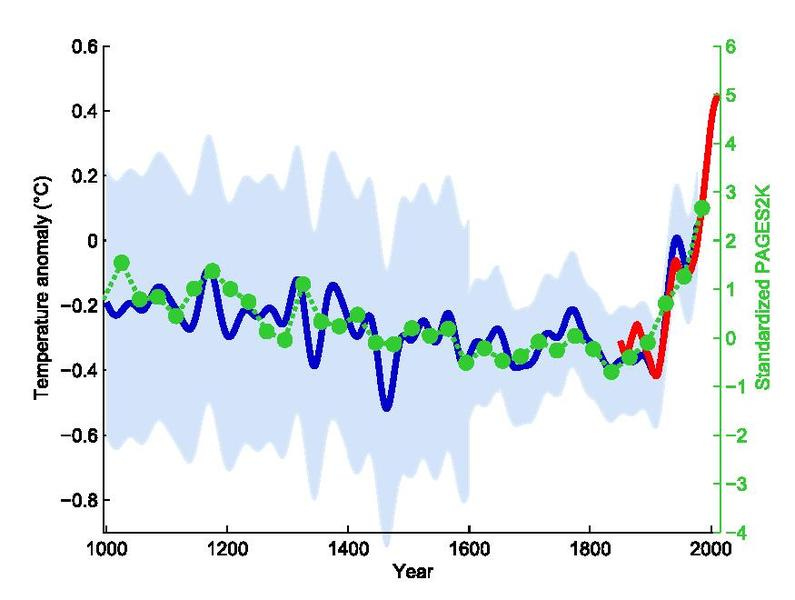The Hockey Stick on Trial
The famous climate change graph finds itself centre-stage in a Washington DC defamation law suit...
Premier Persuasion!
Do you remember the ‘hockey stick’ graph?

It’s a temperature reconstruction shaped, well, like a hockey stick!
It shows how the world’s temperature (apparently) consistently and slowly declined for the best part of a thousand years until around 1900 when it takes a sharp up-tick, corresponding exactly to the time that human’s industrialised and started to burn hydrocarbons in significant quantities.
It’s a VERY persuasive graph.
It will have left countless people around the world with little doubt as to the reality of human-caused climate change.
It’s authors are highly credentialed climate scientists with distinguished careers. The IPCC have used the ‘hockey stick’, it will have been cited thousands of times across academia, made countless appearances in the media, and will have been included in school and college text books the world over.
Why wouldn’t we be persuaded by this combination of simple, powerful messaging and such a long list of credentials to back it up?!
‘Hide the Decline!’
As it turns out, this graph has been the subject of much controversy since it’s original publication a quarter of a century ago.
As well as criticism from a pure mathematical/ technical standpoint, many have gone as far as to declared it as outright ‘fraud’.
The so-called 2009 ‘Climate-Gate scandal’ in particular cast doubt after an (alleged) whistleblower released emails from the Climate Research Unit at the University of East Anglia, England, that many believe to discuss ways in which key scientists could manipulate the ‘hockey stick’ data, removing hitherto recognised cold and warm periods that didn’t fit ‘the story’.
(The email’s authors do, of course strongly deny such claims and place a different interpretation of the language contained within the ‘leaked’ emails that were purported to demonstrate data manipulation).
Enter Steyn and Simberg
Then came along a couple of blog posts in 2012, in which the science behind the ‘hockey stick’ graph was criticized, as was a follow-up investigation undertaken by Penn State University out of who’s science department the work originated.
While being far from the first to criticize the ‘hockey stick’, these particular blog posts became the subject of what has now been a 12-year defamation law suit against their authors.
The suit is being brought about by one of the hockey stick’s authors, Michael E Mann, in Washington D.C.
The blog posts authors and defendants are the comedian, author and chat show host Mark Steyn and his fellow-Canadian, author, mathematician and rocket scientist, Rand Simberg.
‘From Penn State to the State Pen’
Steyn and Simberg compared the ‘phoney-baloney’ (Steyn’s words!) investigation of the ‘hockey stick’ with that of another, high profile scandal that Penn State were involved with.
A Penn State football couch was found guilty of the systematic molestation of boys attending the university. Senior figures at the university were also found guilty of enabling and covering-up these horrific crimes.
There was corruption at the core of the same academic institution responsible for overseeing and investigating Mann’s work.
Academic turns Celebrity!
Mann claims to have suffered financial and reputational damage as a result of Steyn and Simberg’s claims of fraud, and their comparisons of the handling of his investigation with that of the child molestation scandal.
This is in spite of Mann having become something of a ‘climate celebrity’ since the blog posts were published.
Mann has rubbed shoulders with A-list celebrities such as Leonardo DiCaprio, and has met with influential politicians and heads of state such as Bill Clinton.

The stage is set!
And so the stage is set for a fascinating court room drama!
As I write this the case is approximately half way through. I have been following the case day-by-day which you can also do by, for example, listening to daily updates on this podcast that uses actors to reenact the main events of the day.
Steyn is representing himself and so we have the pleasure of listening to him deliver statements and cross-examine witnesses in his own words. It is difficult not to admire Steyn’s intellect, wit and ability to articulate his case, despite his ill-health (sadly Steyn has suffered three heart-attacks in recent years and is currently wheel-chair bound).
‘Climate Change’ on Trial?
Here’s my summary of some of the most interesting questions emerging from this trial;
Can Mann actually demonstrate that he has suffered material damages, in spite of his rapid rise into the upper echelon’s of ‘climate celebrity’ following the publishing of the ‘hockey stick’ graph?
What are we - and more importantly the jury - to make of Mann himself, and his demonstrable history of litigation, abuse, and name-calling of credentialled scientists that are sceptical of the mainstream climate narrative?
Why, exactly, did Mann repeatedly claim to be a ‘Nobel Prize recipient’ even after the Nobel committee themselves asked him to refrain from doing so?
Can we place any credibility on the Penn State investigation that cleared him of any misconduct, given the horrendous culture of corruption in the top-tier of the university at that time?
Should we place any value on the Climate-gate email leaks from the University of East Anglia that on the face of it discussed the use of ‘trickery’ in the production of the ‘hockey stick’ graph?
And ultimately, is the hockey stick based on bad or even ‘fraudulent’ science? For example, are we really to believe that proxy temperature data taken from a single tree in Canada is representative of the entire northern hemisphere many hundreds of years ago?
Scientific questions are not decided in court rooms. But what makes this case so interesting is that the validity of one of the persuasive pieces of climate ‘science’ ever produced - the ‘hockey stick’ temperature reconstruction - is effectively on trial.
Both the plaintiff and the defence will have a rare opportunity to call witnesses to the stand, to give testimony, to offer cross-examination, and, under threat of perjury, have their arguments play out in public.
The case will not hinge exclusively on the validity of the science behind the graph itself. But it remains a central and important question, not least because Steyn and Simberg’s defence will benefit if enough doubt can be cast from a technical standpoint.
I will be following up with more detail from the case.
Make sure you are subscribed!
-T





